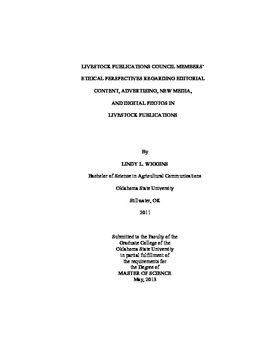| dc.contributor.author | Wiggins, Lindy Lee | |
| dc.date.accessioned | 2014-09-24T14:18:19Z | |
| dc.date.available | 2014-09-24T14:18:19Z | |
| dc.date.issued | 2013-05-01 | |
| dc.identifier.uri | https://hdl.handle.net/11244/11132 | |
| dc.description.abstract | The purpose of this study was to describe the ethical perspectives of LPC members' employees regarding selected issues in the livestock publications industry, including digital photo manipulation and use of new media. Additionally, the study sought to determine if a relationship exists between those ethical perspectives and the personal and professional characteristics of LPC members' employees. The study targeted employees of publication members of the LPC who had an email address on file with the association (N = 645). Descriptive research methodology was used to analyze the respondents' ethical perceptions regarding livestock publication content, advertising, digital photo manipulation, and new media.The typical respondent was a 44-year-old female with a bachelor's degree in agricultural communications or journalism; who is employed by an organization that produces a print publication; and who is responsible for writing, editing and photography. While respondents generally agree the livestock publications industry and LPC have clear codes of ethics, nearly a quarter of respondents are not sure. More than half do feel strongly that ethical responsibility has an effect on the public perception of a publication's credibility. Respondents indicated the goal of livestock publications professionals should be to serve as communications representatives for the livestock industry and provide information to other members of the industry.Respondents utilize new media, including Facebook, Twitter, YouTube and LinkedIn, more than once a day. They strongly believe new media should follow the same ethical standards as print publications. The topic of digital photo manipulation created dichotomous groups among respondents. While one quarter indicated recent technological developments have not made it more acceptable to alter photos within publications, nearly 20% of respondents somewhat agree it has become more acceptable. A narrow margin separated those who said advertising photos could be altered freely and those who strongly disagreed.Based on the results of this study, the LPC and its member publications should revise their codes of ethics to include guidelines for digital photo manipulation and new media. Additional research should be conducted to further investigate the acceptability of digital photo manipulation techniques and to gain understanding of the opinions of livestock publication readers. | |
| dc.format | application/pdf | |
| dc.language | en_US | |
| dc.publisher | Oklahoma State University | |
| dc.rights | Copyright is held by the author who has granted the Oklahoma State University Library the non-exclusive right to share this material in its institutional repository. Contact Digital Library Services at lib-dls@okstate.edu or 405-744-9161 for the permission policy on the use, reproduction or distribution of this material. | |
| dc.title | Livestock Publications Council Members' Ethical Perspectives Regarding Editorial Content, Advertising, New Media, and Digital Photos in Livestock Publications | |
| dc.type | text | |
| osu.filename | Wiggins_okstate_0664M_12732.pdf | |
| osu.accesstype | Open Access | |
| dc.description.department | Agricultural Education | |
| dc.type.genre | Thesis | |
